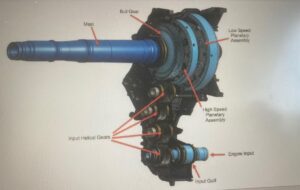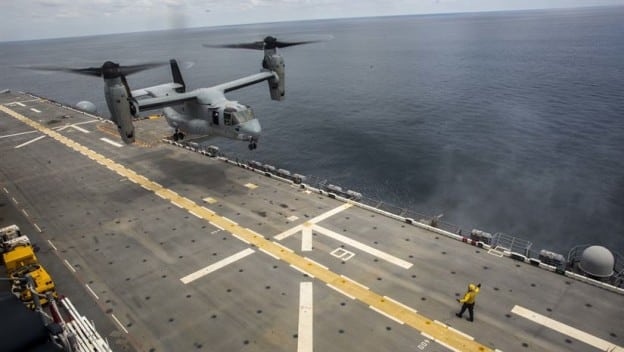The V-22 Joint Program Office manager expects the Ospreys to finally move back to unrestricted flight operations by the end of 2026 once several component changes to improve safety are implemented, he said during a recent conference.
Notably, the metal used in the Osprey’s Proprotor Gearbox (PRGB) is being melted three times to bake out impurities, which industry experts think is “going to reduce the inclusions by about 90%, and which is why it’s becoming, I guess you would say, it’s becoming the new industry standard,” Col. Robert Hurst, PMA-275 V-22 Joint Program office program manager, said during the annual Modern Day Marine conference on April 30.
The inclusions are impurities that weaken the steel.
He said an unnamed “very good” industry partner three years ago determined they can melt the metal a third time to make it better, so they should include that in gearboxes currently being produced.

Hurst said the V-22 PRGB are currently being cut with the stronger steel and are set to start in January 2026 because the industry partner “really stepped up and helped us out with some of the long lead material, raw material differently.”
As a result Hurst said he believes DoD will make the V-22 “probably unrestricted by the end of next year.”
Despite Hurst’s confidence, this confirms further delays fixing the Osprey fleet. In June 2024, commander of Naval Air Systems Command Vice Adm. Carl Chebi told lawmakers the V-22 would not likely get back to unrestricted flight operations until the middle of 2025 as they looked at what material and non-material changes to make (Defense Daily, June 12, 2024).
The PRGB changes are meant to further decrease problems from hard clutch engagements that may lead to loss of control of the aircraft. Those engagements had occurred for years, but there was a jump in 2022, including one that led to a fatal MV-22 crash in June 2022. That crash led to a requirement that clutch replacements would occur after 800 flight hours.
More recently, a November 2023 CV-22 crash off the coast of Japan led to another fleet grounding.
The Marine Corps’ latest Aviation Plan from February noted new sensors are being installed on V-22s to better predict when parts need to be replaced to avoid potentially deadly incidents.
This includes the Osprey Drive System Safety and Health Instrumentation (ODSSHI) to install sensors in critical areas of the aircraft’s PRGB and drivetrain. The document also first noted the utility of the more refined triple-melt steel that will “drastically reduce the likelihood of material defects in critical gears and bearings” (Defense Daily, Feb. 7).
The V-22 program is also working on a redesigned Input Quill Assembly (IQA) that seeks to reduce a wearout mode found in previous IQA failures that led to hard clutch engagement (HCE) issues.

Until the improved steel for the proprotor gearbox, redesigned IQA, and ODSSHI is fully installed, the V-22 continues to operate under flight restrictions. The Navy and Marine Corps are only allowed to fly them within 30 minutes of a divert field, which the Navy operators generally translate into 200 miles. The Ospreys are supposed to have a range of 1,150 miles.
Hurst said the program is moving on all of these improvement measures in parallel “so we want to, as soon as it’s ready, implement it in the fleet.”
Last year at the same Modern Day Marine program presentation, the previous V-22 Joint Program Office manager said they were studying future upgrades that would potentially allow the fuselage to last for several decades past the current service life of the early 2060s (Defense Daily, May 3, 2024).
